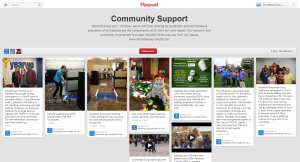Erik Qualman's Blog, page 634
June 20, 2013
Insurance Companies Banking on Being More Social

 Social media has many impacts on everyday life, but who would have thought that insurance companies would be making good use of social networking?
Social media has many impacts on everyday life, but who would have thought that insurance companies would be making good use of social networking?
It seems odd to think that insurers are hanging out on Facebook or Twitter but an increasing number of insurance companies are doing just that. While it might seem silly to think of the people behind the scenes as a little lizard tapping on keys or a beehive-haired lady taking calls, insurance companies are more accessible than ever thanks to social media.
Whether you’re at home or out and about – insurance companies are vying for your attention.
Customer Service
Social networks like Facebook and Twitter have amazing results in customer service when applied properly.
For people that are involved in accidents, they can take pictures and email or upload them to the insurer’s account instantly. Using smart phones, this means that a claim can be made right away. In fact, help can be just a few clicks away with some companies. When social media staff is online (which can be at any hour for some companies), you can get answers then and there.
Many companies use social media for customer service.
Where insurance companies get this done right is when they can inspect claims instantly. Not only can they see pictures, they can receive and respond to voice recordings from claimants.
Also, customers having an issue with an insurance company can upload their pictures on their own pages and make them public while tagging the insurance company instead of posting directly to the company’s account.
Gaining Customers
With the popularity of social media, looking for insurance of all types has become easier.
By using hashtags on Twitter potential customers can check out insurance companies. Facebook and Twitter gives customers a chance to see how insurance companies interact with customers on a personal level, along with the various coverages that are out there, ranging from homeowners and auto protection to title insurance.
Social media can also reveal the dark side of companies to reviews or even spoof websites that are created by disgruntled customers. Farmers Insurance has more than 2.3 million followers on Facebook, MetLife has a half-million; two insurers who get social media well it seems.
Going Mobile
Another aspect to the social movement with insurance companies is the evolving world of apps.
Phone apps are available for all sorts of companies. Insurance companies have created apps that allow customers to upload claim pictures, voice recording, and even send questions.
Similar to social networking, apps allow users an almost instant connection. Smart phones are an almost perfect solution for using social media and using an insurance company – mobile and ready at a moment’s notice in case of accidents.
Building a Brand
Even insurers mascots are having a ball on social media.
Flo from Progressive has her own page, and so does Mayhem from Allstate. These “personalities” are almost bigger than the insurance, so branding is an important marketing ploy for these companies.
One last thing that insurance companies are using social media for – while not greatly publicized, is to find out about fraudulent claims.
People that use social media to make claims about accidents (such as workers compensation cases) and then post about going to do physical labor or about how they’re really not hurt, find themselves losing claims.
While this might sound sneaky, social media is helping keep costs down when people made false claims, especially when they expose their false claims on their own.
So, is your insurance company becoming more social?
Photo credit: wawatson.com
[image error]
June 19, 2013
Business Travelers Becoming More Social

A recent survey by Embassy Suites Hotels showed that 85% of business travelers would follow a hotel or other travel brand on social media to learn about travel deals, reviews by other customers, and the brand’s latest news.
Social media has become an integral part of modern life, and business travelers are following the trend. Here’s some more information on how social networking sites are changing the way business people travel.
By the Numbers
In the Embassy Suites Hotels survey, almost 80% of respondents said the economy has changed their business travel habits in the last five years. Many are switching to teleconferencing for at least some of their long-distance business needs.
When they do travel, 29% of respondents said they are under more pressure from their employers to find greater value hotels. Twenty-five percent said they only fly economy due to cuts in travel budgets.
Finding Deals
Companies are looking to cut costs wherever they can, and this has resulted in more business travelers looking for bigger deals and better value.
Social media can help them find discount flights, take advantage of rewards programs, and find cheap New York hotels or accommodations in other cities.
By following hotels, airlines, and other travel brands on social media, these travelers can keep up on each company’s current news — which can help them save time or money on their next trip.
Checking Reviews
More than three quarters of the survey respondents said that online travel reviews are critical to their travel decisions. Using social media and other online resources, they can find experiences from other customers to help them determine whether they’re getting a good value on their trip.
Online reviews can also help a traveler avoid hazards in the destination city (such as hotels in high crime areas). And reviews can be a quick way to decide where to take a business lunch or the best places to hold a meeting.
During the Trip
Business travelers aren’t just using social media to plan their trips. They also use their networking sites to help them stay connected and get around while they’re away.
Travelers can ask their networks for reviews or research to help them find restaurants or places of interest, and can use online maps to help them get there. Location-based social networks also provide a useful tool, showing where others in their network have been.
Social media can also help business people send photos and other updates back to their colleagues at the home office. Live updates from a business meeting or conference keep the whole department informed, helping to increase the company’s efficiency and adding value to the trip.
If you’re planning to travel for business and are on a tight budget, your online social networks may be a goldmine of information.
By taking advantage of these resources and the experience of people in your networks, you can save yourself a lot of time and money when planning your trip.
Photo credit: Askmen.com
[image error]
June 17, 2013
Consolidation of the SoLoMo sector
The combination of social networking and smart phones with location-based GPS capabilities are offering new consumer monetization opportunities, such as location-based search marketing, mobile social networking and social/mobile commerce. This simply means that the concepts of social, location, and mobile are coming together in a meaningful way. Customer engagement and purchases in specific industries such as shopping, travel, dining, and entertainment are increasingly more common on mobile devices. A recent study by PEW Research found that a third of all Americans own and operate a smart phone. Location based related click-through-rates are already higher on mobile devices than on desktops and laptops and this is only expected to continue throughout this year. According to another study by Global Industry Analysts, Inc. the location-based advertising market is expected to grow to $12.8 billion by 2017 and per ABI Research, mobile commerce is expected to reach $119 billion by 2015.
Location-based marketing has historically been fueled by companies like FourSquare, and this trend of earning recognition or rewards for “checking-in” to a specific location is only gaining in popularity. The implementation of Facebook Places has taken an already popular social networking site and added an extra layer, which is centered around mobile use. Facebook has also recently acquired FourSquare’s principal competitor Gowalla, which will give the social media giant more comprehensive location-based capabilities. Other innovative emerging companies in the SoLoMo sector that have gained mindshare with consumers include, Glympse, a location sharing service and Locationlabs, a location tracking services for families.
Another area that is gaining traction is micro location-based commerce and advertising. Cascadia predicts that more social and ecommerce sites will continue to incorporate these solutions into their already existing programs and will likely acquire established or growing businesses. For example, in 2011, eBay purchased Where, a company that provides micro-location based advertising to mobile phones based on the user’s location and leverages a particular segment of SoLoMo, called geofencing technology. Cascadia believes that these new innovative services which will gain further consumer mindshare will attract capital from investors and M&A interest from a broad segment of buyers.
Kushal Saha is a Managing Director in the Information Technology practice at Cascadia Capital with a focus on the Internet and New Media theme. Saha originates, manages and executes all facets of M&A, recapitalizations, private equity and debt placement transactions.
[image error]
June 12, 2013
Growing Customers Means Growing Relationships
Growing Customers Means Growing Relationships
Using Facebook to build trust and friendships with your clientele
Whether you’re the head of a multi-national conglomerate or a stay-at-home mom with a small knitting business, you’re probably aware that Facebook has become an excellent means of promoting your business. But that doesn’t necessarily mean that business comes flowing in simply by casting a virtual net and gathering in as many friends as possible. What companies across the board are beginning to learn is that relationships — more than advertising and constant promoting — are what drive up fan bases, customer loyalty and eventually, sales.
Late last year, Facebook announced that it was launching a test of their new Pay-to-Promote platform in the United States. Only available to a small percentage of U.S. members with less than 5,000 friends, the platform allows users to pay a test price of $7 to move their posts up in their friends’ news feeds.
Reviews are mixed so far and some are questioning its effectiveness (and whether or not the promoted posts will be marked as such on news feeds, or if they will just appear as part of the regular feed).
What does this mean for businesses, which have already had the ability to pay to promote posts? That depends on what you’re trying to do and how you do it. For most Facebook users, the social media site is just that; a place to socialize. If you’re friends with a business, it’s most likely because you support what they’re trying to do and want to know more about their upcoming activities. At the same time, you want to know them on a personal level. As a business, if you’re regularly blasting friends with posts about sales or pushing certain items, you’re probably going to start losing interest (and friends), fast. If, however, it’s used on a more personal level, such as announcing a special tasting at your bakery for Facebook friends or sharing a photo of the month and congratulating the Facebook user who submitted the image, then it might work in your favor. As users begin to pay to promote posts, the importance of quality content in both paid and unpaid posts will increase. Only posts with real value will gain the audience you seek.
The main point is that Facebook appears to be much more effective when it is used more to build customer trust and relationships, and less to sell. In fact, General Motors pointed this out last May when it decided to discontinue advertising with the social media mogul. In a provided statement, the company pointed out that, while they were no longer advertising, Facebook, “continues to be a very effective tool for engaging with our customers,” and they would continue to use it as such.
Whether your business has one employee or three hundred, thirty friends or more than five thousand, the rules of good business are as strong as they always were. If you get to know your customers, build up your relationships with them and garner their trust, you build customer loyalty. This, in turn, causes your clients to spread the good word about you and encourage others to use your services.
Here are a few ideas to help you get started on building more social media relationships for your business:
Keep it personal: Reach out to your customers on a personal level. If you own an auto parts store, share a piece of advice, such as how to use isopropyl alcohol to remove engine oil from hard surfaces. If you’re a baker, share an anecdote about what you learned after accidentally leaving the eggs out of a cake recipe. Sharing on a personal level helps others relate with your business and keeps you in their minds.
Share pictures: Whether you hold regular events at your brick-and-mortar storefront or simply want to encourage your customers to share how they use your products, sharing tagged pictures on Facebook is a great way to get in a little promotion for your business with your customers and their friends. By holding a monthly photo contest, for example, with tagged images of your customers using/wearing/sharing your product, your product is not only shared on your Facebook page, but on the pages of your customers and their friends, as well.
Participation rewards: Rewarding customers for interacting with your site is an excellent way to promote your business and encourage them to keep coming back. For the more advanced Facebook users, creating games and offering reward points for participating, or giving reward points for sharing a post or participating in a poll, could translate to discounts (for example, receive 25% off your next purchase with 500 reward points) either through online or brick-and-mortar store purchases.
If you’re still learning the ins and outs of Facebook, however, something as simple as giving away a free extra scoop of ice cream for one day at your restaurant with the mention of the offer on your Facebook page is a great way to get more people signed up and involved with your company.
What ways have you found to reach out and build relationships with your customers? In what ways do you feel social media allows you to stay more connected with your clientele?
Erin Schwartz manages marketing programs for 123Print.com, a leading provider of high quality customizable items like business cards, address labels, postcards, and other promotional printing materials for small businesses and solo practitioners.
[image error]
June 10, 2013
How to Use Pinterest to Highlight Your Company


Pinterest can effectively be used to showcase your company’s caring, “human” side.
Sometimes companies appear to be all about business – an all work, no play scenario. By now, most people know that customer engagement is a key factor in customer retention, and not allowing your company’s personality to show can be detrimental to its success.
Showing off the heart of the company is simple – document the “less corporate” things by putting them on Pinterest. Here are three ways to use Pinterest to showcase your company’s personality and heart:
#1 Pin Pictures of Employees Serving the Community
If your company has at least a few employees, it is likely that one of them does some volunteer work. Find out how your employees like helping the community, and ask to take photos of them in action.
A good example is Randstad Sourceright US Careers’ board “Community Support”, shown below, which showcases employees volunteering at various charity events. Remember, to maintain a great board, you must continually pin pictures to it to keep your Pinterest followers engaged.

Randstad Sourceright US Careers shows off its community support by pinning photos on Pinterest.
#2 Display the Office Life
If your employees are happy, and have a sense of humour, showing off the “office” life will be easy. No, these are not photos of your employees sitting at their desks while typing away at a computer. These are pictures of your employees bringing in a birthday cake for the intern, or engaging with others at events. Even simpler, but just as important, moments can show off how fantastic your employees are, such as a group photo at the end of the day on a Friday.
The best part about this is that you can use your imagination! Pin anything that shows that you and your employees are real human beings and have a personality. Check out Startup America’s boards for great examples of their employees in action at various events.
#3 Have Fun Boards Too
When companies only pin pictures of their products, they’re page looks boring. Avoid this by showing off your entertaining and funny side!
A fun board has pins that showcase humour related to your company and industry. For example, if you have a marketing company, a fun board may be titled “Marketing Gone Wrong” and could showcase pictures of funny advertisements that didn’t do so well; or check out the Anaheim Ducks’ “Hockey E-Cards” board for an example of an organization using humour to engage with their fans by pinning photos such as the one below.

Anaheim Ducks pins plenty of hockey humour on their board “Hockey E-Cards”.
Share Your Goods
It is always good to have separate boards with specific titles, but you also have to continually pin to the boards – don’t pin 10 photos at one time and then forget about it! Also, remember to not be too serious; avoid controversial pins about politics, drugs, etc. Your Pinterest page should showcase you, and your employees, as hard-working, community helpers with great personalities. Lastly, share your pins on other social media networks as well! This creates consistency among all of your company’s profiles.
Author: Sabreena Thouli
What other ways do you use Pinterest to showcase your company/organization?
[image error]
June 7, 2013
Want Something to Go Viral on Social Media? Turn on the Visuals
 Every fulltime social media manager for a brand experiments with the content he or she produces, and then looks at weekly, monthly, or quarterly reports to see what was stickiest with his or her audience. It’s a fundamental principle in giving people more of what they show they want and getting better at weaving your content inside of the communities on various platforms.
Every fulltime social media manager for a brand experiments with the content he or she produces, and then looks at weekly, monthly, or quarterly reports to see what was stickiest with his or her audience. It’s a fundamental principle in giving people more of what they show they want and getting better at weaving your content inside of the communities on various platforms.
Social media image from Bigstock
For instance, “Tumblr is a community that rewards doing one thing consistently well,” writes Dan Fletcher on Shtterstock’s blog. “That’s why sites devoted to a specific meme thrive on Tumblr.”
With that wisdom in mind, the editors of Bigstock’s blog went to work to create “The Memes of Spring,” a lighthearted look at the joys of the outdoors for both people and animals. For this post, an editor and a designer paired up to create this buzzy, fun, and visual article. It resulted in a big win for Bigstock, as the post was shared on Facebook at 14X the reach of a typical post. Now, the editors are coming up with ways to replicate that success.
What’s difficult about this prospect is striking the right balance. Occasionally, you’ll miss. Great content will go unseen. But what’s great about it is that anyone can do it. You can even learn how to make viral content for the web, if you are short on ideas.
Here are the Bigstock editor’s key takeaways from the “Spring” hit:
Be topical with the idea.
Make it shareable with the syndication.
Show variety with both.
It’s that last point that often goes overlooked. When Bigstock shared the post on Facebook, because it was built as a meme, they had the chance to roll out one picture at a time, as often as they liked. They didn’t spam their followers, but added more to the conversation over time. The pictures that drew more conversation and Likes on Facebook drove more attention and clicks.
In today’s age, where so much chatter and clicking is taking place on social media channels, it’s important to produce content that will be attractive there. This means thinking backwards a bit. Pursuing specific audiences is a long-held tradition for content creation, but the platforms where people will be engaging with the article or video matters a great deal. In attention to who you’re trying to reach, consider what channel you hope to conquer with this content.
The “Spring” post was modeled off of what appears to work well on Tumblr and Facebook. It looks like it belongs there. To achieve that synergy, you need to start the conversation about the vision for both the content and the syndication at once. If you do, you can increase engagement and interest by giving people more of what they want.
Danny Groner is the manager of blogger partnerships and outreach for Bigstock.
[image error]
June 5, 2013
The 5 Habits of Teenagers on Social Media Today

When it comes to social media there are tons of flavors ranging from the “generic” Facebook to the eclectic Vine and Snapchat. Teenagers are notorious for being experimental and checking out new things, and not just following the norm. When it comes to social media, it’s not much different.
1. My Mom’s on Facebook: Nowadays with the influx of individuals in their 30s, 40s, 50s and older joining and becoming more active on Facebook, teenagers are becoming less active or less willing to share as much on the platform. They feel it’s “less cool” and also don’t want their parents to see everything they share. Although there are privacy settings, it’s not the same when it’s not a place they can share so freely as they did before their parents joined.
2. Photos, Photos, and more Photos: We all know that photos are some of the most shared pieces of content across social media and when it comes to teenagers it’s not much different. Teens love to take and share photos, especially on apps like Instagram where you can play around with the filters and make them look unique and fun. Additionally, teens feel they can have just as good of a conversation on Instagram as they had on Facebook through the comments under pictures.
3. Privacy? - Teens although caring about not having their parents see their content, are sometimes more carefree with what they share. Some pictures show more than they should; they share contact information; and connect with as many friends and celebrities as possible – because they can.
4. tumblr - A quick and easy location for teens to blog about their daily lives, passions, and follow brands they love. It’s a way for them to expand on their careers during high school and college and get noticed sooner. Your resume only says so much, your blog can say so much more nowadays.
5. Try it and Move on - As the shiny object syndrome proves, there are so many social media channels that teens try new ones, get bored, and find a new one the following week. Some last longer, but they need real traction to do so including being easy to use, share, and have their friends join too.
What does this all mean you ask? If brands want to reach this target audience, they need to keep an eye on what’s hot for teens, and where they are interacting the most. It may be not facebook, but instagram, tumblr, twitter, and other easy to use and share platforms (especially visual) seem to be great venues to find and engage these teens.
Note: Some of this information was obtained through speaking with high school graduates and college freshmen and what they prefer on a daily basis and why.
Further Reading:
http://socialmediatoday.com/leaderswe...
http://www.edsocialmedia.com/2013/05/...
[image error]
May 31, 2013
Toy Makers Investing in Social Media

Social media, with its ability to reach a huge percentage of consumers, is an important tool for any company, and toy makers are no exception.
But there’s a right and a wrong way to use social media, as some companies in other industries have shown with their high-profile online meltdowns.
Here’s what toy companies need to know to use social networking to their advantage.
Why Social Media is Important
According to HubSpot, social media brings in almost twice as many marketing leads as trade shows, telemarketing, or direct mail, and those leads have a 13% higher conversion rate than average.
Why does social media perform so much better than traditional marketing efforts?
Part of the answer is the personal connection you can form with customers through social networking channels. These sites allow you to form your company’s unique voice, and build trust with consumers.
Social media profiles also allow you to better interact with your consumers. And with 46% of online users relying on social media to help them make a purchase decision, your online presence is more important than ever. Whether you’re selling preschool toys or nursery cribs, social media can help deliver your message to the countless parents in need of such items.
Toy Companies Who Get It
To better illustrate the point that social media has an important role to play in marketing for toy companies, here’s a look at a couple of successes.
First is Step2, a U.S. company selling preschool and toddler toys in the $50 to $200 price range. At these price points, consumers tend to do more research before making a purchase decision — and this is where Step2 has used social media to its advantage.
The company started using a review software service that integrated Facebook profiles of people who left reviews for toys on Step2′s website. This social integration allowed people to follow reviewers they liked, and raised Step2′s product visibility on Facebook. This drove a 300% bump in revenues from Facebook-referred visitors since October of 2010;
Another U.S. toy company with an effective social media strategy is Jakks Pacific.
Jakks uses DIGG and YouTube to promote their company and products, but their social media strategy doesn’t stop there.
They also pitch bloggers in the parenting, collector, and tech niches to help showcase their products to their followers. The benefit of this strategy is that these bloggers already have the trust of their readers, so when they recommend or showcase a product it’s more likely to catch the interest of potential customers.
How You Can Be Successful With Social Media
If you’re a toy maker looking to use social media to boost your sales, here are a few things to keep in mind:
* Social media is all about…well, being social. Interaction is the key. You won’t get far by just posting new product notifications on your social feeds. You also need to answer customer questions and join in conversations to put a human face on your company;
* Be creative. Twitter and Facebook are great, but their real power lies in sharing your other content, such as videos and blog posts. Create lively, informative, and entertaining content and use social media to promote it, and you’ll see better results;
* Target your efforts. With more than 200 social media sites available, you should choose the ones your customers are most likely to frequent. Twitter and Facebook are good first steps…but are your customers likely to be active on Pinterest? Google Plus? Focusing on sites where your customers are will save you time and energy.
Social media can be a powerful marketing tool for toy companies.
By thinking creatively and doing a little market research, you can give your customers the interaction with you that they want, and boost your bottom line.
Photo credit: 123rf.com
[image error]
May 29, 2013
Using Social Media to Tackle Online Predators

Sexual predators are everywhere, especially online where they can have a special type of anonymity.
They can “pose” being anything they need to be – a 12-year-old girl, a respectful grandma, or a close friend of the target. With the ability to be anything they say they are at the moment, sexual predators find most social media sites to be a haven for activity.
However, some social media sites are fighting back and there are some things you can do to help secure you and your child.
Myspace
A social media staple before the eruption of Facebook, Myspace is targeting predators.
They have security personnel that trolls around seeking out online predators, and when they find sexual predators in their database, they’ll delete them out. Removing up to 30,000 people a week on average. If your child wants to be on a social media site, consider Myspace. Always keep a watch on your child while they are online, but at least with Myspace they are actively seeking out predators to delete.
If you or your child just have to be on Facebook, there may not be security set in place to take out predators before they can get to you, but they do have some customized features designed to help.
You can go into your account and restrict your account to a “friends only” show. This only allows people that you accept into your friends list to be able to see your posts and to contact you. However, Facebook also has in play a feature that allows someone that isn’t your friend to message you if they pay $1 for the privilege. Weigh your options on this one.
Laws in Place
There are now laws in place where sex offenders are going to have to leave a trail wherever they go.
In the U.S., 10 states have already put legislature in place that state that sex offenders must list an email address in their documents. Laws are already in place that state that a sex offender must register at his new location whenever he moves, this just adds an email address for the predator. However, we all know how easy it is to get an email address, especially “throwaway” email addresses.
Laws That Are Proposed
There is even a further reaching piece of legislation that has been offered.
Attorney General of North Carolina Roy Cooper has offered up a law that states that there should be parental consent for children to be online on social media sites. The plan here is that if a child needs parental consent, there will end up being fewer underage children on the sites for predators to have contact with.
Diligence
It really all boils down to watching your children or you yourself taking precautions to ask questions when you meet someone online. Don’t assume anything and don’t form trust with someone who could be the direct opposite from his/her online persona.
Social media does have its pitfalls, but as a concerned parent or a wary singleton, you can help make sure that you are safe online. If it feels wrong, or it sounds strange, never give in to the “what-if”.
Always choose safety over new friends and new experiences.
Photo credit: trendhunter.com
[image error]
May 24, 2013
Lawyers Making Their Case for Social Media

Social media can be a source of supporting evidence for law practices, especially in family law and worker’s comp cases.
But as well as learning to trawl Facebook for incriminating photos and status updates, lawyers are turning to social media to promote their services to customers.
One recent study by LexisNexis discovered that more than three-quarters of Americans seeking a lawyer go online to carry out their search. You might expect Google to be their first stop, but it seems the majority of consumers’ online searches for lawyers now take place on Facebook instead.
Which Social Media Sites are Best for Lawyers?
If Facebook’s where people go searching for a lawyer, then you’d expect every lawyer to have their own professional Facebook Page, right?
In fact, maintaining a Facebook presence is typically a lower-priority tactic for law firms.
One reason for this quirk is that not everyone who searches for a lawyer on Facebook will actually hire one; the high volume of searches has more to do with the high volume of Facebook users than anything else.
The most popular social network used by lawyers is LinkedIn, with Facebook and Twitter distant runners-up.
There are a few social networks aimed specifically at the legal profession, like LawLink and Legal OnRamp, but those aren’t suitable for connecting with potential clients because they’re populated purely by other law professionals.
Getting Social Media Right
Some lawyers shy away from using social media because of state laws surrounding the provision of legal advice and the solicitation of clients, while others are put off by fear of breaking ethical codes by forming social media friendships between attorneys and judges.
The right social media site for lawyers is a matter of strategy and aptitude.
If you’re a solo attorney, you have to make the call: will you spend precious time on Twitter or get on with more pressing concerns? Law firms, on the other hand, are more likely to have social media marketing campaigns run by the in-house marketing department or an external agency.
Who’s Leading Lawyers in Social Media?
There are a few law firms in the U.S. that really stand out for making excellent use of social media in their marketing. The greater their social media success, the more likely that other law firms will follow suit.
The law firms that have the biggest social media presence are Eversheds, Allen & Overy, and Taylor Wessing, according to research by Living Ratings.
These firms all make a point of updating their social media accounts several times a day to keep their brand in the public eye, which is a key survival trait in social. They’ve learned to listen to social media as much as they talk through it, getting to know their followers (and customers) better in the process.
Social media marketing takes more than a few personal tweets and an empty Facebook page.
For lawyers willing to commit time to building a loyal following, though, it may be well worth getting the jump on your competitors by moving into social before they do.
About the Author: Sophie Lizard is a freelance blogger on social media marketing and other business topics, currently researching a story on real estate title service companies.
[image error]






